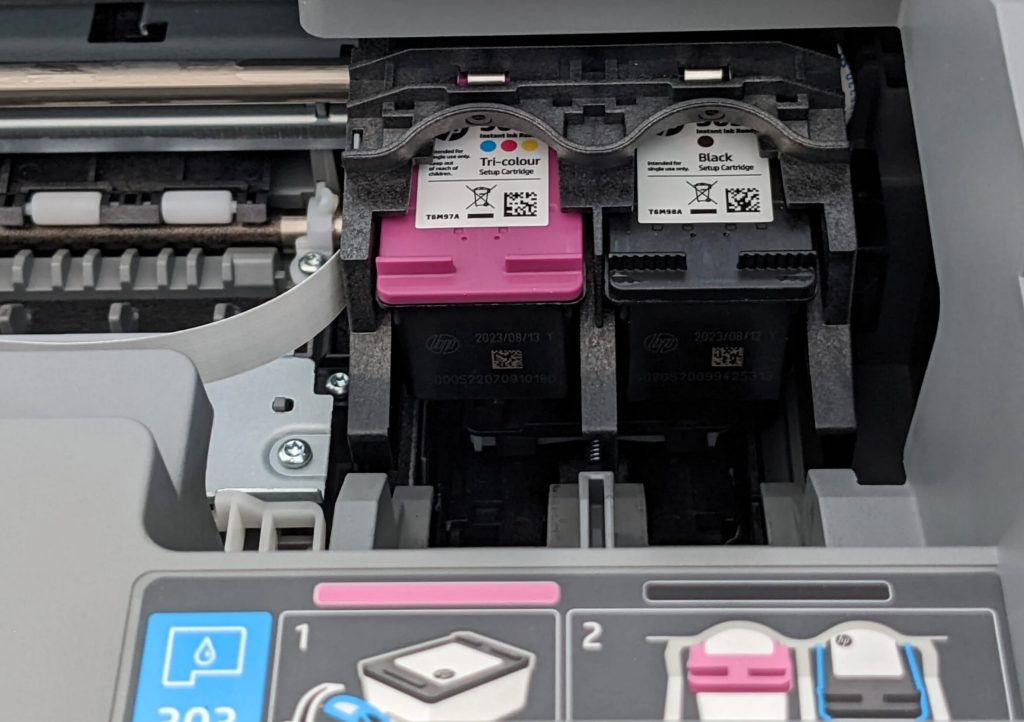Choosing the right printer for your needs (guide 2023)

Choosing the right printer for your needs depends on your use, print quality expectations, durability, and budget. Even if we limit the choice to inkjet or laser, there are considerable differences in per-page costs and print quality.
Throughout this guide, we use C (Cyan), Magenta (M), Yellow (Y) and Black (K). These can mix the whole sRGB colour gamut (what you see on a monitor). We only refer to printers for Home and for SOHO (small office/home office) use.
Some photo printers may have extra cartridges to add grey, white or other half-tones. These are not included in this guide.
The printers mentioned in this guide are not endorsements, but rather objective reviews of the different types of printers.
Choosing the right printer – advance summary
If you buy a:
- Budget inkjet printer <$200. The print cost may be as high as 50 cents per page, and the replacement ink cartridge/head may be more than the printer’s cost.
- Mid-priced inkjet printer $200-300. The cost may be as high as 20 cents per page, but you replace individual cartridges when they are empty.
- Higher price ink tank printer $300-600. The cost per page ranges from a fraction of a cent to a few cents, and you refill the ink tank when necessary – no waste.
- Lower-cost laser, the cost per page is around 15 cents a page, and you change toner cartridges when necessary.
Print costs – Ink per ml is more expensive than French perfume!
These prices are averages, and you may get far better deals on bulk purchases from online ink and toner specialists.
Inkjet
Cartridge printers with integrated print heads from 4 pages per minute
Canon, HP, Brother or Epson all have low-cost inkjets, usually <$100 using tri-colour cartridges with integrated print heads.
These have CMY (they fake the K). The cartridge costs between $40-60 and has an estimated life of 150-200 sheets. That is 25 cents per page, and if you run out of one colour before the rest (invariably yellow), you must change the cartridge and waste the remaining ink. Some printers in this category cost over 50 cents a page.
Some have separate black and tri-colour cartridges. Here the Black cartridge costs $30-40, and if you print mono, only it costs 16 cents per page. If you print colour (CMYK), it averages 20 cents a page.
Buy if your print use is low, you don’t mind waiting for low-speed printing, and you don’t intend to keep it for more than a year or so.
HP Envy Inspire 7220e all-in-one A4 printer (review)


Replaceable individual CMYK cartridges (no print head) from 5 pages per minute
A black cartridge with a mono print yield of 750 pages costs $20-30 or about 4 cents a page.
Separate CMY cartridges cost about $20-30 each (60-90 for three), and a CMYK pack costs around $120-150. Each cartridge should print around 250 pages, but when printing spot colour and photos, you usually get a combined total of about 1000 pages or about 15 cents a page. The advantage of separate cartridges is that you only replace the used ones.
But if your print use is low to moderate, have a little more budget and care about print costs.

Inktank, EcoTank, MegaTank, Inkvestment, CISS – from 10 pages per minute
These printers have refillable CMYK tanks and a print head that lasts the rated life of the printer (usually at least 100,0000 pages). Refill bottles cost about $20-25 each and should print around 6000 pages per colour or at least 10,000 in CMYK. Print cost is less than a cent a page – often a fraction of a cent.

They have higher upfront costs, but you get your investment back after as little as three reams of print: far lower running costs, longer durability and less waste.
Epson EcoTank ET-2850 printer – no cartridges, just economical ink (review)
Epson EcoTank Pro ET-5150 – a very smart printer (review)
Brother MFC-J4540DW INKvestment printer comes with a year’s ink (review)



Laser – from 20 pages per minute
These home and SOHO lower-cost lasers are pretty much the domain of Brother and HP and start as low as $500 for a colour MFP. These generally need separate CYMK toners (4), but the cheaper ones may use an all-in-one head.
The advantage of laser is that it can print relatively glossy images on plain paper, whereas inkjets are duller unless you use expensive clay-coated paper.
Laser toner/drums tend to cost from $120-200 per colour – $480-800 per set. While you get about 1000+ pages from each, the combined CMYK is closer to 5000 pages, from 10-15 cents.

You will occasionally have to replace the waste toner collector, and there may also be a maintenance kit cost.
Buy if you need higher speeds, better colour, and faster speeds.
Lexmark MC3426i Colour MFP laser printer – economy and speed (review)
Lexmark MB3442i Mono MFP laser printer is very fast (review)

Dodgy print speeds
Most printers quote ISO Pages per minute, and in theory, this is a guide because it bears little resemblance to reality.
Over 98% of printing is a single sheet. That means it must RIP (Raster image process) the page and download it to the printer, which interprets the image to push out the right colours. This delay is called ‘first page-out’ and can vary from around 5-10 seconds (fast) to nearly a minute (where the printer needs to compose the entire page in memory before printing).
First, page-out delays apply to subsequent pages, but this is usually done while a previous page is printing unless the printer has insufficient internal memory.
If you print longer documents, look for the maximum internal memory.
Genuine ink/toner or not?
There is a massive debate over using genuine versus third-party ink and toner.
The bottom line is that while the device is under warranty, use genuine; then it is your call.
How many reams (500 sheets) do you print per year?
You are less worried about replacement ink costs if you print less than 500 sheets a year. Using the 500 pages a year and the above as a guide
- A cheap integrated print head will cost $125 in ink.
- Individual cartridges will cost $75.
- Ink tanks will cost $5.
If you print more (the average 2+2 family prints about three reams a year), you are looking at $375/225/15 for one year. Over three years, that is $1125/657/45.
A compelling argument for a refillable ink tank printer.
Printer features – what do you need?
Most printers are either print-only or have MFP (multi-function) features. Some offer mono models that may be perfect for your use. If you need occasional A3 print, there are models for that too.
Input/Output capacity
Most printers have at least a 100-page input (via a cassette or sheet feeder) and output bin capacity. Some also have bypass feeders for heavier stock.
Depending on your needs, you may want to look for extra capacity via a second cassette or larger output tray.
Placement
Most printers output to the front, meaning you need extra space there. Some output to the back, meaning you cannot place them against a wall.
Regardless you need to know the overall footprint – not just the printer footprint – and which sides you need to leave room for access.
Screen
A status screen is useful and allows use without a PC. The larger, the better.
Look at the menu system and see if you can easily access it.
Scanners
All scanners will do basic mono and colour scanning at 300 to 600DPI. Don’t go overboard – get a better, well-made scanner over one with higher resolution specs that you will never use.
- Flatbed – if you only scan a few pages a year.
- Single-sided, auto document feed (ADF): If you scan single-sided, multipage documents.
- Two-sided (Duplex) ADF: If you scan a mix of single and two-sided documents. This is the one most SOHO and small business users need.
Scanner software will come with the printer and should allow you to scan to email, cloud, print, or fax.
Scanners can be uncooperative, so look for a large paper feed roller; even better if they are replaceable spare parts.
Fax
Fax does not generally work with NBN Broadband phones, so it is no longer a vital feature. It is easier to scan and email something.
Two-sided (duplex) paper print
Most MFPs have duplex printing, and it saves paper that only costs one cent a sheet. If you print booklets, you may need duplex, and the printer driver should support book printing and duplex on the long or short side of the paper.
Connection – USB, Wi-Fi, Ethernet
- USB means it connects to one PC/Mac – no or limited sharing with other PCs.
- Wi-Fi means any computer or smartphone can connect over the home network.
- Ethernet is the cabled version of Wi-Fi.
- Wi-Fi Direct means the printer has its own Wi-Fi SSID (name) and password, and you can connect a PC or smartphone to it to print.
Unless this printer is solely for your use, connect via Wi-Fi so the family can share it.
Energy Use
- Cartridge/print head inkjets use around 30-50W when printing.
- Cartridge inkjets use a similar amount.
- Inktank printers vary from 5W (Epson), Canon 10-14W and Brother 15-20W.
- Lasers can use 400W+.
All have sleep modes that consume <1W. The trade-off here is speed versus energy use. A laser can be five times faster than a cheap inkjet, evening out an energy use imbalance.
The age-old question is, “Do you leave the printer on all the time?” The answer is that it is best left on when a printer uses heat to propel the ink or toner (laser). It regularly purges a small amount of ink to keep the nozzles from drying out and blocking.
Epson PrecisionCore does not use heat and can be turned off.
Print Quality
Inkjets use plain paper (75 to 80gsm bond) that sucks up the ink and gives the dullest colour print. Black text is usually crisp, but you may see colour bleed and cheaper inkjets may show colour banding.
Officeworks has HP ColorChoice High White A4 90/100gsm for $14.98/16.59 (500 sheets) or 120gsm for $13.29 (250 sheets). It also has HP Pro Design 90/100/120gsm clay coat for presentation printing.
Lasers print a glossier image on plain paper and light stock as the toner is fused to the paper.
Inkjet photo printers generally use special inks (Dye, not pigment) and photo papers.
Speciality print
Inkjets generally handle most speciality paper types, including labels and banners. You may have to buy inkjet-compatible versions of overhead transparencies (OHP).
Lasers generally handle A4 paper from 75-120gsm. They require laser-compatible OHPs and labels to withstand heat/fusion.
PC, Mac, Android, and iOS compatibility
The majority of modern printers have drivers for PC/Mac and Apps for Android/iOS.
Linux and Chrome users need to check if there are drivers/apps for that.
Reliability
As a rule, printers have at least a 12-month ACL replacement warranty. Some, like Epson, extend that to 2 years if you register the printer online (so they can email you with special offers).
My retail spies quip that for each $100 you spend, you can expect it to last that long, e.g., $500 or five years.
All home/SOHO printers have a duty cycle. For example, the Epson EcoTank Pro ET-5150 – a very smart printer (review) has three reams a month, and a 100,000-page warranty overrides the time warranty. This is not unusual, and at least Epson reveals that.
Home/SOHO Printers do generally not have spare parts like paper and scanner rollers. Again, see if there are any page limitations on the scanner if you intend to use it a lot.
Bottom line – the more you pay, the longer it will last. Read the warranty for time overrides. If your use exceeds the duty cycle, you must buy a printer that meets that amount.
Printer setup and use issues
If a printer does not set up properly or easily, it is a pretty good chance that it is the PC, Mac, or Wi-Fi home network you are attaching it to.
The most common setup problem is that your old printer still has installed drivers, so look for a driver removal tool on that brand’s website. Then run Wise Disk Cleaner and Registry Cleaner – read Five free Windows programs that will save your bacon.
The next major issue is connectivity. If the driver does not find the printer on Wi-Fi, use a USB cable and later sort out why your home Wi-Fi is not connecting.
If all else fails, take it and a laptop, back to the store and ask for help. Here larger companies like Officeworks will generally assist at no cost. Smaller retailers are entitled to charge a fee for testing and installing before determining if the printer needs warranty replacement.
Recycling
At the end of its life, try to take it back to the retailer for proper disposal. Officeworks will accept the brands it stocks.
Spent ink cartridges can also be recycled via Cartridges 4 Planet Ark website. Drop-off partners, including Australia Post, JB Hi-Fi and Harvey Norman, accept any used or empty laser and inkjet cartridges.
CyberShack’s view – Choosing the right printer for your needs comes down to what you can afford
Despite the best advice in this guide, home users tend to shop on price. The old adage ‘You get what you pay for’ is never more true with printers. And it does not matter which brand – Canon, Brother, HP and Espon all have a range of printers from ink-guzzling cheap inkjets to ink-miser Ink Tanks.
Our best advice – of you want the printer to last and have low running costs go for an Ink Tank model.
Choosing the right printer, Choosing the right printer, Choosing the right printer, Choosing the right printer







